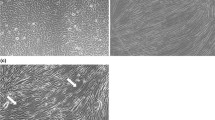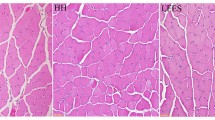Abstract
Weak electromagnetic fields (WEF) enhance Ca2+ entry into cells via voltage-gated Ca2+ channels and affect various aspects of metabolism, structure, and function. However, little information is available on the effect of WEF on skeletal muscle, which depends primarily on intracellular Ca2+ stores for function and metabolism. Here, we examine the effects of 30 min exposure of rat primary myotube cultures to WEF (1.75 μT, 16 Hz) on Ca2+ handling and creatine kinase (CK) release. Free myoplasmic Ca2+ concentration ([Ca2+ i]) was measured with the ratiometric dye indo-1. WEF did not affect basal [Ca2+]i but decreased the twitch [Ca2+]i transient in a time-dependent manner, and the twitch amplitude was decreased to ∼30 % after 30 min. WEF completely abolished the increase in [Ca2+]i induced by potassium chloride (∼60 mM) but had no effect on the increase induced by caffeine (∼6 mM). Hypoxia (2 h exposure to 100 % argon) resulted in a marked loss of CK into the medium (400 % of normoxic value), as well as a rapid (within 20 min) and sustained increase in basal [Ca2+]i (∼20 % above baseline). However, during exposure to WEF, basal [Ca2+]i remained constant during the initial 60 min of hypoxia and, thereafter, increased to levels similar to those observed in the absence of WEF. Finally, WEF blocked about 80 % of hypoxia-mediated CK release (P < 0.05). These data demonstrate that WEF inhibits increases in [Ca2+]i by interfering with muscle excitation and protects against muscle damage induced by hypoxia. Thus, WEF may have therapeutic/protective effects on skeletal muscle.





Similar content being viewed by others
References
Adey WR (1981) Tissue interactions with nonionizing electromagnetic fields. Physiol Rev 61:435–514
Aley PK, Porter KE, Boyle JP, Kemp PJ, Peers C (2005) Hypoxic modulation of Ca2+ signaling in human venous endothelial cells. Multiple roles for reactive oxygen species. J Biol Chem 280:13349–13354
Allen DG, Lamb GD, Westerblad H (2008) Skeletal muscle fatigue: cellular mechanisms. Physiol Rev 88:287–332
Allen DG, Westerblad H (1995) The effects of caffeine on intracellular calcium, force and the rate of relaxation of mouse skeletal muscle. J Physiol Lond 487(Pt 2):331–342
Armstrong CM, Bezanilla FM, Horowicz P (1972) Twitches in the presence of ethylene glycol bis(-aminoethyl ether)-N, N′-tetracetic acid. Biochim Biophys Acta 267:605–608
Bawin SM, Adey WR (1976) Sensitivity of calcium binding in cerebral tissue to weak environmental electric fields oscillating at low frequency. Proc Natl Acad Sci U S A 73:1999–2003
Bruton J, Jeffries GD, Westerblad H (2014) Usage of a localised microflow device to show that mitochondrial networks are not extensive in skeletal muscle fibres. PLoS One 9, e108601
Chen L, Lu XY, Li J, Fu JD, Zhou ZN, Yang HT (2006) Intermittent hypoxia protects cardiomyocytes against ischemia-reperfusion injury-induced alterations in Ca2+ homeostasis and contraction via the sarcoplasmic reticulum and Na+/Ca2+ exchange mechanisms. Am J Physiol Cell Physiol 290:C1221–C1229
Clausen T (2013) Excitation-induced exchange of Na+, K+, and Cl− in rat EDL muscle in vitro and in vivo: physiology and pathophysiology. J Gen Physiol 141:179–192
Ebashi S, Endo M (1968) Calcium ion and muscle contraction. Prog Biophys Mol Biol 18:123–183
El-Ani D, Stav H, Guetta V, Arad M, Shainberg A (2011) Rapamycin (sirolimus) protects against hypoxic damage in primary heart cultures via Na+/Ca2+ exchanger activation. Life Sci 89:7–14
Endo M (2009) Calcium-induced calcium release in skeletal muscle. Physiol Rev 89:1153–1176
Fagan JM, Wajnberg EF, Culbert L, Waxman L (1992) ATP depletion stimulates calcium-dependent protein breakdown in chick skeletal muscle. Am J Physiol 262:E637–E643
Fixler D, Yitzhaki S, Axelrod A, Zinman T, Shainberg A (2012) Correlation of magnetic AC field on cardiac myocyte Ca(2+) transients at different magnetic DC levels. Bioelectromagnetics 33:634–640
Grynkiewicz G, Poenie M, Tsien RY (1985) A new generation of Ca2+ indicators with greatly improved fluorescence properties. J Biol Chem 260:3440–3450
Itegin M, Gunay I, Logoglu G, Isbir T (1995) Effects of static magnetic field on specific adenosine-5′- triphosphatase activities and bioelectrical and biomechanical properties in the rat diaphragm muscle. Bioelectromagnetics 16:147–151
Katz A (1997) Differential responses of glycogen synthase to ischaemia and ischaemic contraction in human skeletal muscle. Exp Physiol 82:203–211
Maglara AA, Vasilaki A, Jackson MJ, McArdle A (2003) Damage to developing mouse skeletal muscle myotubes in culture: protective effect of heat shock proteins. J Physiol 548:837–846
Mamedova LK, Shneyvays V, Katz A, Shainberg A (2003) Mechanism of glycogen supercompensation in rat skeletal muscle cultures. Mol Cell Biochem 250:11–19
Morabito C, Rovetta F, Bizzarri M, Mazzoleni G, Fano G, Mariggio MA (2010) Modulation of redox status and calcium handling by extremely low frequency electromagnetic fields in C2C12 muscle cells: a real-time, single-cell approach. Free Radic Biol Med 48:579–589
Osorio-Fuentealba C, Valdes JA, Riquelme D, Hidalgo J, Hidalgo C, Carrasco MA (2009) Hypoxia stimulates via separate pathways ERK phosphorylation and NF-kappaB activation in skeletal muscle cells in primary culture. J Appl Physiol 1985 106:1301–1310
Pall ML (2013) Electromagnetic fields act via activation of voltage-gated calcium channels to produce beneficial or adverse effects. J Cell Mol Med 17:958–965
Petecchia L, Sbrana F, Utzeri R, Vercellino M, Usai C, Visai L, Vassalli M, Gavazzo P (2015) Electro-magnetic field promotes osteogenic differentiation of BM-hMSCs through a selective action on Ca(2+)-related mechanisms. Sci Rep 5:13856
Piacentini R, Ripoli C, Mezzogori D, Azzena GB, Grassi C (2008) Extremely low-frequency electromagnetic fields promote in vitro neurogenesis via upregulation of Ca(v)1-channel activity. J Cell Physiol 215:129–139
Ruff RL, Simoncini L, Stuhmer W (1988) Slow sodium channel inactivation in mammalian muscle: a possible role in regulating excitability. Muscle Nerve 11:502–510
Schneider MF, Chandler WK (1973) Voltage dependent charge movement of skeletal muscle: a possible step in excitation-contraction coupling. Nature 242:244–246
Seta KA, Yuan Y, Spicer Z, Lu G, Bedard J, Ferguson TK, Pathrose P, Cole-Strauss A, Kaufhold A, Millhorn DE (2004) The role of calcium in hypoxia-induced signal transduction and gene expression. Cell Calcium 36:331–340
Shainberg A, Burstein M (1976) Decrease of acetylcholine receptor synthesis in muscle cultures by electrical stimulation. Nature 264:368–369
Shainberg A, Yagil G, Yaffe D (1971) Alterations of enzymatic activities during muscle differentiation in vitro. Dev Biol 25:1–29
Snyder WS, Cook MJ, Nasset ES, Karhausen LR, Howells GP, Tipton IH (1975) Report of the task group on reference man. Pergamon, Oxford, U.K
Stern MD, Silverman HS, Houser SR, Josephson RA, Capogrossi MC, Nichols CG, Lederer WJ, Lakatta EG (1988) Anoxic contractile failure in rat heart myocytes is caused by failure of intracellular calcium release due to alteration of the action potential. Proc Natl Acad Sci U S A 85:6954–6958
Walleczek J (1992) Electromagnetic field effects on cells of the immune system: the role of calcium signaling. FASEB J 6:3177–3185
Weber A, Herz R (1968) The relationship between caffeine contracture of intact muscle and the effect of caffeine on reticulum. J Gen Physiol 52:750–759
Westerblad H, Bruton JD, Katz A (2010) Skeletal muscle: energy metabolism, fiber types, fatigue and adaptability. Exp Cell Res 316:3093–3099
Acknowledgments
This research was supported by a grant from the Gasner Foundation.
Author information
Authors and Affiliations
Corresponding author
Ethics declarations
All experiments were conducted according to the guidelines of the National Institute of Health for the care and use of laboratory animals and approved by the institutional review board of Bar Ilan University.
Conflict of interest
The authors declare that they have no conflict of interest.
Rights and permissions
About this article
Cite this article
Adler, D., Fixler, D., Scheinowitz, M. et al. Weak electromagnetic fields alter Ca2+ handling and protect against hypoxia-mediated damage in primary newborn rat myotube cultures. Pflugers Arch - Eur J Physiol 468, 1459–1465 (2016). https://doi.org/10.1007/s00424-016-1837-2
Received:
Revised:
Accepted:
Published:
Issue Date:
DOI: https://doi.org/10.1007/s00424-016-1837-2




